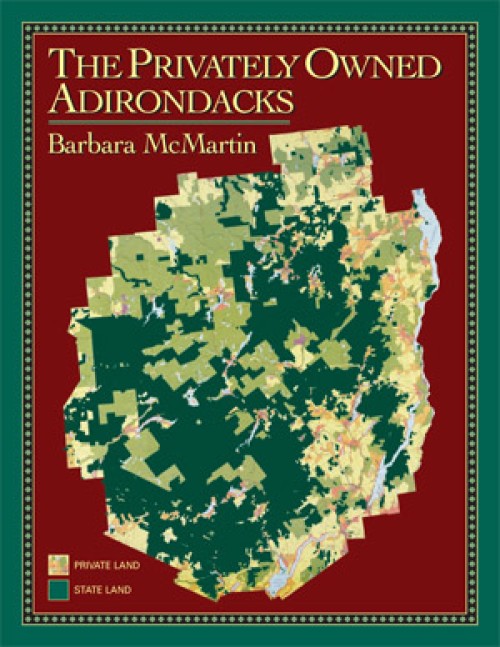by By Barbara McMartin
Lakeview Press, 2004
If you were to climb the recently reopened Azure Mountain fire tower on a clear day, you would see an immense arc of the Adirondacks, from the Park’s northern edge to the High Peaks. You might think you were looking at a vast expanse of public forest – it is, after all, inside a park. But by far the greater portion in view is privately owned.
It may come as a surprise that over half the Adirondack Park is private property. This land belongs to individuals, families, businesses, corporations, and clubs, and unless it has an easement or some other right of access attached to it, you and I can’t go there without the proper connections. This state of affairs may not fit the concept of a park in most people’s minds, but it’s a double-edged fact of life in the Adirondacks, one that renders the region both distinctive and a management migraine without surcease.
In The Privately Owned Adirondacks, Barbara McMartin has once again set her prodigious energy, research skills, and writing ability to the task of explaining how things work in the Adirondacks. Private holdings, despite their predominance, are by their nature less well known than the public parts of the Park, which constitute the “forever wild” Forest Preserve. And there are those who resent their existence. Yet they, and by extension the people who owned (and own) them, have played a major role in the tangled story of the Adirondacks for 250 years.
In her introduction, McMartin reveals her attitude toward her subject: “New Yorkers [recognize] that public land alone may not be able to protect all the park’s values – wildlife, watersheds, forests, the preservation of wilderness and open space. Private ownership of land is the basis of the forest and tourist industries. Without the latter, public access to the Adirondacks would be severely limited….This book is a celebration of the values of lands that remain in private ownership.”
Addressing trends she details in a subsequent chapter, she continues, “Reasons for owning land in the Adirondacks change over time, beginning with creating fishing and hunting preserves and exploiting the woods. Many early landowners hoped for profit in breaking up huge tracts. Some emulated the English landed gentry’s patterns of land ownership. Later owners sought land in this gentle wilderness that offered nature’s beauty and solace from an increasingly frantic industrial society. A few used their land as a means of displaying wealth…. Altruism among landowners appeared very slowly in the twentieth century, when people began to realize that protecting land was an important reason for owning it.”
The stage set, McMartin goes back to the beginning, when wealthy speculators snapped up monumental acreages in the years surrounding the Revolutionary War. These were followed in the early 1800s by rapacious lumbermen and, in their footsteps, railroad speculators. Ownership of land for the purpose of hunting and fishing soon followed; those iconic activities remain two of the principal reasons for ownership, although such ideals as privacy, protection of the forest, and family bonding grew over time.
The years following the Civil War saw a burst of sporting club formation as wilderness recreation became both more economically possible and more socially acceptable. This development brought about two themes that have dominated discussions among landowners to the present day, with no signs of being resolved: taxation and forest management. McMartin explains the evolving philosophies and the motivations, sometimes pure and sometimes not, behind steps taken to deal with these vexations. Leasing grew in popularity; with more intrigue than a cheap novel, it grew into a modern-day flashpoint as many of the large landholders that for generations leased chunks of their holdings to clubs have been gobbled up by mega-corporations that have chosen to divest.
In this, her 24th book, McMartin believes she has taken the quest for answers as far as she will ever be able to do. If indeed this is to be her final work, what a splendid conclusion to a career of helping us all better understand that conundrum called the Adirondacks.


